Green Streets
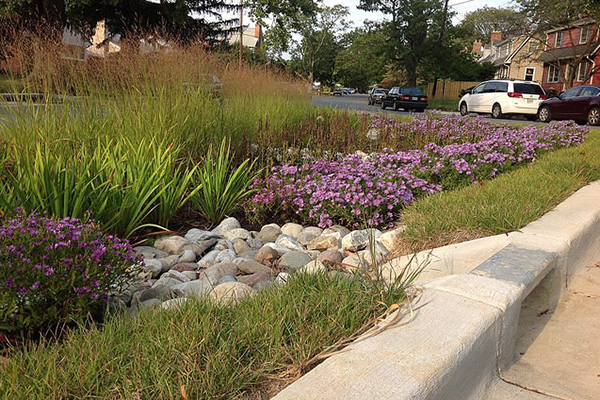
Green Streets are innovative landscaping designs that play a leading role in reducing and filtering stormwater runoff. As part of a county initiative, these streets are designed to capture stormwater runoff in neighborhoods that lack adequate stormwater controls. Green Streets are constructed within the street rights-of-way, making them an efficient, sustainable – and beautiful – solution to address stormwater management. Join us to learn more about the benefits, design principles, and success stories of Green Streets in our community.
Together, let’s pave the way for greener and more resilient neighborhoods.
Green Streets offer a wide range of advantages that contribute to creating vibrant and sustainable communities. Here are some key benefits:
- Aesthetically Attractive Streetscapes: Green Streets enhance the visual appeal of neighborhoods by incorporating beautiful landscaping and enhancing the natural beauty of our communities. These green spaces create a pleasant, restorative natural environment for residents, pedestrians, and motorists alike.
- Natural Habitat for Pollinators and Birds: By incorporating native plants and trees, Green Streets provide essential habitats for pollinators such as bees, butterflies and birds. These biodiverse environments contribute to the overall health and diversity of local ecosystems.
- Reduction of Stormwater Runoff: One of the primary objectives of Green Streets is to mitigate stormwater runoff. Using various techniques such as permeable pavement, bioretention areas, and rain gardens, Green Streets help to capture and filter rainwater, reducing the strain on traditional stormwater infrastructure. In addition, the plant roots absorb rainwater as food.
- Visual Connectivity between Neighborhoods, Schools, Parks, and Business Districts: Green Streets serve as visual connectors within communities. They create an inviting atmosphere, among community landmarks such as neighborhoods, schools, parks, and business districts, fostering a sense of unity and natural beauty.
To learn more about the benefits of Green Streets, we invite you to explore our comprehensive Green Streets brochure (PDF). Discover how these innovative designs are transforming our neighborhoods and promote a greener future.
Types of Green Streets Practices
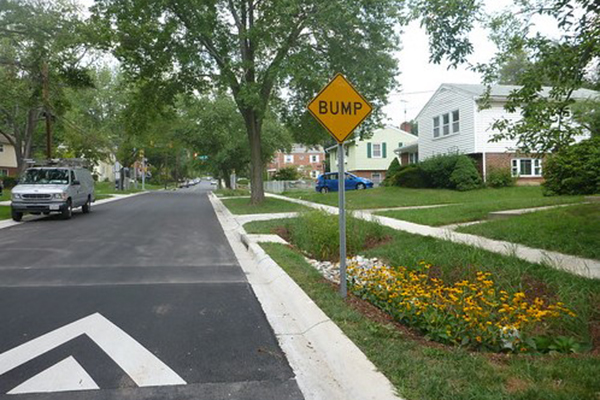 Rain Gardens
Rain Gardens
A rain garden is a shallow depression in the ground that is strategically planted with native plants. It acts as a natural filtration system, allowing rainwater from roadways and other impervious surfaces to collect and slowly absorb into the ground. The native plants in the rain garden help to filter pollutants and enhance water infiltration, promoting a healthier local ecosystem.
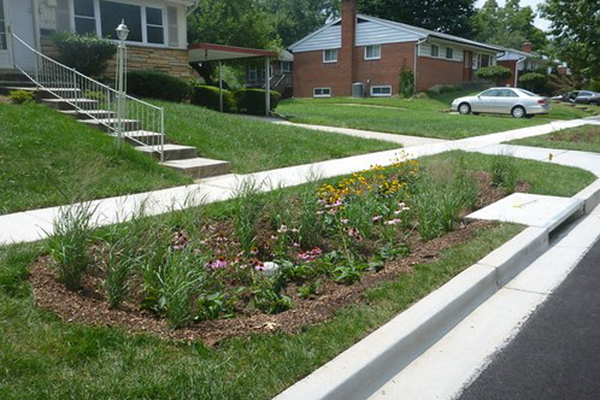 Bioretentions
Bioretentions
Like rain gardens, bioretentions are designed to capture and treat stormwater runoff. They typically feature a gravel layer with an underdrain pipe that is connected to a nearby storm drain. This pipe helps drain the facility after rain events, ensuring that excess water is properly managed and does not allow mosquitoes to breed. Rain gardens and bioretentions add beauty to streetscapes by creating an attractive green space that provides ecological benefits, especially to our pollinators.
 Tree Boxes
Tree Boxes
These mini bioretention boxes are designed to capture and treat stormwater runoff while incorporating shrubs or trees in areas with limited space. The inclusion of shrubs or trees adds aesthetic appeal and provides additional environmental benefits such as shade, air purification, and wildlife habitat.
 Pervious Surfaces
Pervious Surfaces
Pervious Sidewalk, Permeable Pavers and Pavement removal are innovative solutions that help manage stormwater runoff and promote a more sustainable urban environment. These porous solutions enable water to pass through and be absorbed by the underlying soil. This promotes natural filtration and helps recharge groundwater levels and helps minimize the strain on stormwater infrastructure.
 Curb Extensions
Curb Extensions
Curb extensions are smart urban design elements placed within the road right-of-way between the curb and the sidewalk. These extensions often involve expanding the curb into the parking lane, allowing for additional space and a larger treatable drainage area. By removing sections of pavement, curb extensions help manage stormwater more effectively, reducing the risk of flooding and enhancing water quality. While implementing curb extensions requires adequate space and careful planning to minimize the impact on parking, their benefits in improving pedestrian safety and enhancing the overall aesthetic appeal of our streets make them a valuable addition to Montgomery County’s urban landscapes.
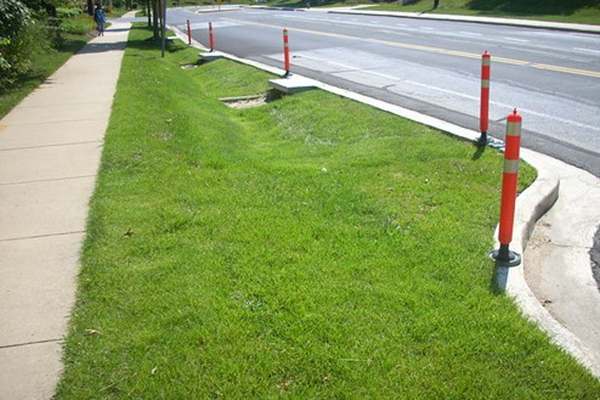 Swales
Swales
Grass swales are features designed to manage stormwater runoff effectively. By allowing runoff to percolate into the ground, they help reduce the amount of water leaving the roadway during rain events. Grass swales are a wonderful example of how sustainable solutions can be both practical and environmentally friendly, contributing to the health and beauty of Montgomery County’s urban landscapes.
Frequently Asked Questions
What do Green Street practices look like?
Green Streets features come in various designs, each tailored to suit the specific needs and aesthetics of the neighborhood. For instance, rain gardens or bioretention areas are often bowl-shaped, and some may be sodded or landscaped with plants and mulch. On the other hand, tree box filters consist of a square inlet containing a tree or small shrub(s) within a filter box filled with bioretention soil mix. Landscape designers collaborate with the County to develop visually pleasing designs that not only connect neighborhoods but also foster a sense of community identity.
For more visual references, explore the DEP Flickr website to see examples of these sustainable practices in action.
Who is responsible for maintenance?
The Department of Environmental Protection (DEP) takes on the responsibility of maintaining Green Streets. Regular monitoring is conducted monthly to ensure that these practices function optimally. If you have any questions or concerns about the Green Streets practices in your neighborhood, you can reach out to DEP by calling 311 or emailing us at [email protected].
DEP's maintenance efforts encompass various tasks, including ensuring the health of the plants, removing dead or diseased vegetation, replacing plants as needed, replenishing mulch, regular weeding, and removing sediment and trash that may accumulate in the facility. By consistently keeping up these Green Streets practices, we strive to create a more resilient and environmentally friendly community for everyone to enjoy.
How do Green Streets work?
The functioning of Green Streets varies depending on the type of practice, but the general process involves effectively managing stormwater runoff from the roadway. The runoff is first diverted into an inlet opening in the curb, then guided through a mixture of highly permeable soils, such as sand, mulch, and compost. This filtration process helps remove pollutants from the water before it is either stored in an underlying gravel layer, allowing it to percolate into the groundwater, or directed to an underdrain that flows into the storm drain system.
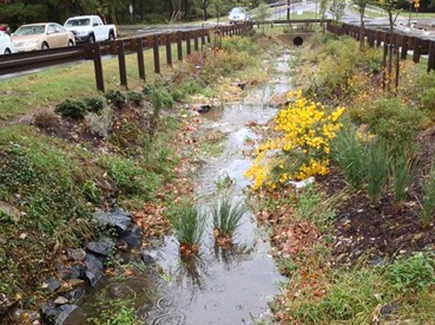 During this process, the runoff has an opportunity to cool down, while the native plants in the Green Street area absorb nutrients, and beneficial microbes around the plant roots help break down pollution. After rain events, certain facilities may retain water, resulting in ponding of up to six inches before draining over a period of 12 to 48 hours, depending on the specific type of facility and site conditions. Through this natural and sustainable approach, Green Streets effectively contribute to managing stormwater and promoting a healthier urban environment.
During this process, the runoff has an opportunity to cool down, while the native plants in the Green Street area absorb nutrients, and beneficial microbes around the plant roots help break down pollution. After rain events, certain facilities may retain water, resulting in ponding of up to six inches before draining over a period of 12 to 48 hours, depending on the specific type of facility and site conditions. Through this natural and sustainable approach, Green Streets effectively contribute to managing stormwater and promoting a healthier urban environment.
In some cases, features may be considered as part of a larger stormwater management technique. This may involve creating open spaces or green areas that can help absorb rainwater. Combined things like pavement removal and tree plantings with other stormwater management strategies, such as rain gardens or bioswales, depending on site conditions can help achieve both neighborhood and water quality goals.
How can I learn more?
A. Email - [email protected] for information on Green Streets in your community.